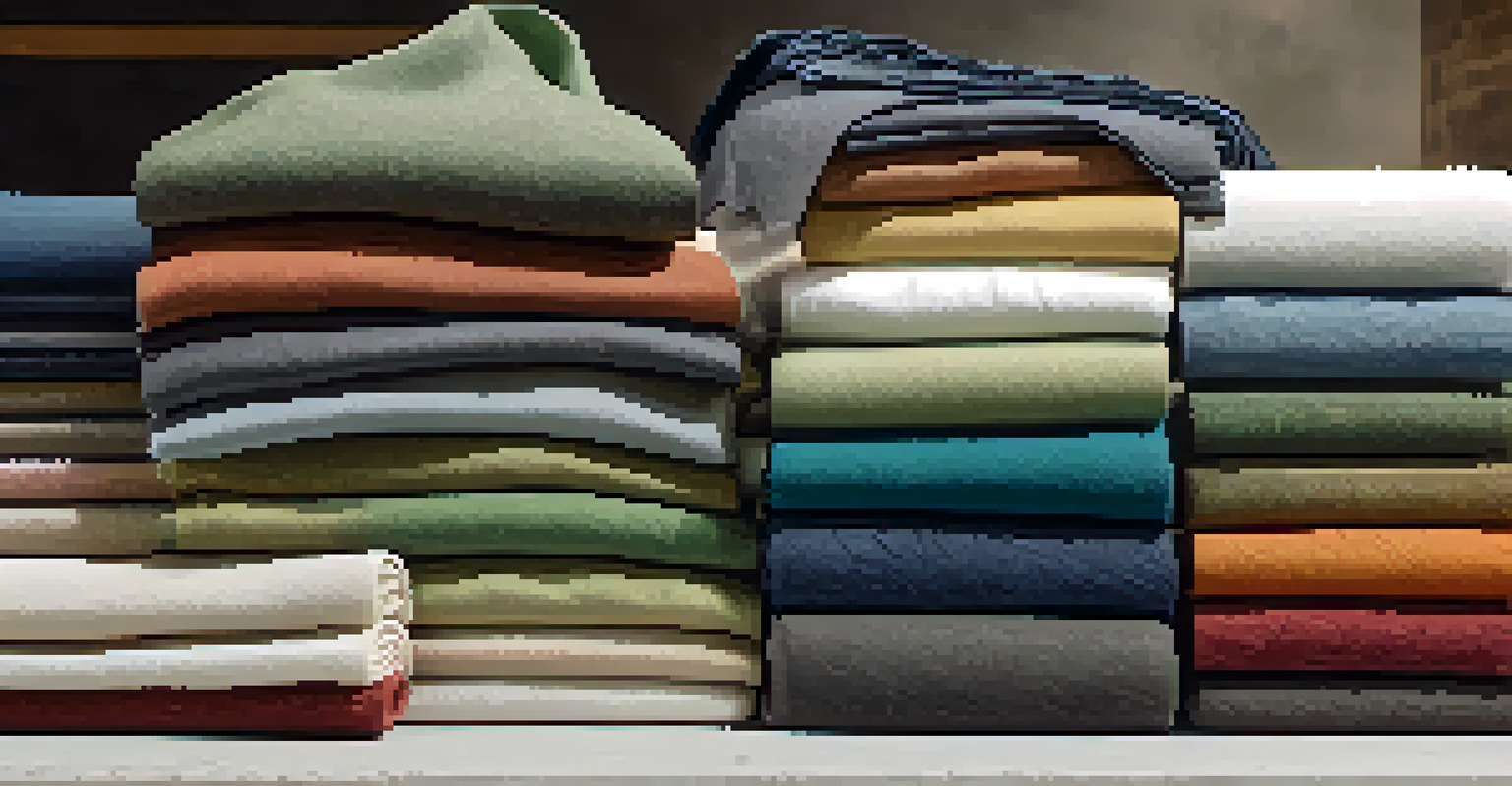Sustainable Fashion: Gender Neutral Clothing for Everyone

Understanding Sustainable Fashion: A Brief Introduction
Sustainable fashion refers to clothing that is designed, manufactured, and consumed in environmentally friendly ways. This movement addresses the environmental impact of the fashion industry, which is known for its significant waste and pollution. By emphasizing ethical practices and eco-friendly materials, sustainable fashion seeks to create a more responsible industry.
Fashion is the armor to survive the reality of everyday life.
For instance, brands are now focusing on using organic materials, reducing water usage, and employing fair labor practices. This shift not only benefits the planet but also encourages consumers to make more informed choices about what they wear. The overarching goal is to minimize the fashion industry's carbon footprint while promoting social responsibility.
Sustainable fashion encourages us to rethink our purchasing habits, advocating for quality over quantity. It’s about creating a wardrobe that lasts, which resonates well with the growing desire for conscious consumerism. As we become more aware of the impact of our choices, sustainable fashion emerges as a compelling alternative to fast fashion.
The Rise of Gender Neutral Clothing in Fashion
Gender neutral clothing has gained traction in recent years, challenging traditional fashion norms. This style is designed to be inclusive, allowing anyone to wear what they feel comfortable in, regardless of gender. The rise of this movement reflects a broader cultural shift towards acceptance and diversity in fashion.

For example, many brands now create collections that feature unisex designs, breaking free from the constraints of gendered clothing. Think of oversized shirts, relaxed-fit jeans, and versatile outerwear that anyone can rock. This not only expands options for consumers but also paves the way for a more open-minded approach to personal style.
Sustainable Fashion Benefits the Planet
Sustainable fashion prioritizes eco-friendly materials and ethical practices to reduce the industry's environmental impact.
By embracing gender neutral clothing, we celebrate individuality and self-expression. This approach encourages creativity and allows people to define their own style without being boxed into traditional categories. Ultimately, this movement represents a significant step towards inclusivity in the fashion landscape.
Eco-Friendly Materials: The Backbone of Sustainable Fashion
Sustainable fashion relies heavily on eco-friendly materials, which are crucial for reducing environmental impact. Fabrics like organic cotton, hemp, and Tencel are popular choices for their lower ecological footprints. These materials often require less water and chemicals to produce compared to conventional fabrics.
Sustainability is no longer about doing less harm. It’s about doing more good.
Many brands are also exploring innovative materials like recycled polyester made from plastic bottles or biodegradable fabrics derived from natural sources. This not only helps reduce waste but also gives new life to materials that might otherwise end up in landfills. As consumers become more aware of these options, demand for sustainable materials continues to rise.
Choosing clothing made from eco-friendly materials is a simple yet effective way to support sustainable fashion. By opting for items that prioritize the planet, we contribute to a cycle of conscious consumption that benefits both the environment and future generations. It’s a small step that can lead to a significant impact.
The Importance of Ethical Manufacturing Practices
Ethical manufacturing practices are essential to sustainable fashion, ensuring that workers are treated fairly and paid a living wage. Many traditional fashion brands have faced scrutiny for poor labor conditions, prompting a call for transparency in the industry. Consumers are increasingly demanding accountability from the brands they support.
For instance, some companies now provide information about their supply chain, allowing consumers to see where and how their clothes are made. This transparency fosters trust and encourages brands to maintain high ethical standards. By supporting ethical manufacturers, we can help uplift communities and promote fair labor practices worldwide.
Gender Neutral Clothing Promotes Inclusivity
The rise of gender neutral clothing allows individuals to express their personal style without being confined to traditional gender norms.
Choosing brands that prioritize ethical practices is not just a trend; it’s a commitment to social responsibility. By making informed choices, consumers can drive change in the fashion industry, advocating for a system that values people over profits. This shift towards ethical manufacturing is vital for a sustainable future.
The Role of Upcycling in Sustainable Fashion
Upcycling is a creative approach to sustainable fashion that involves transforming old or discarded clothing into something new and stylish. This process not only reduces waste but also allows for unique, one-of-a-kind pieces that stand out in a world of mass production. By giving new life to old garments, upcycling promotes a culture of creativity and resourcefulness.
Many designers and DIY enthusiasts are embracing upcycling, turning everything from vintage finds to fabric scraps into trendy outfits. This practice encourages people to think outside the box and see the potential in items that might otherwise be thrown away. It’s a fun way to express individuality while contributing to sustainability.
As upcycling becomes more popular, it’s reshaping our perception of fashion consumption. Instead of constantly seeking new items, we can learn to appreciate and reinvent what we already have. This shift not only saves money but also nurtures a more sustainable relationship with our wardrobes.
Building a Capsule Wardrobe: Practical Tips
A capsule wardrobe is a curated collection of versatile clothing pieces that can be mixed and matched to create numerous outfits. This concept aligns perfectly with sustainable fashion, encouraging us to invest in quality items that last rather than fast fashion trends that quickly go out of style. By focusing on timeless pieces, we can reduce consumption and waste.
Start by assessing your current wardrobe and identifying items you wear frequently or love. Choose a few key pieces that can be layered or combined in different ways, such as neutral tops, classic jeans, or a versatile jacket. This approach not only simplifies your wardrobe but also makes getting dressed a more enjoyable experience.
Upcycling Redefines Fashion Consumption
Upcycling transforms discarded clothing into unique pieces, encouraging creativity and a more sustainable approach to fashion.
Building a capsule wardrobe is also a great opportunity to incorporate sustainable and gender-neutral pieces. By choosing items that fit your personal style and can be worn by anyone, you create a wardrobe that reflects your values and supports sustainability. It’s a practical way to embrace a more conscious approach to fashion.
The Future of Fashion: A Sustainable and Inclusive Approach
The future of fashion is leaning towards sustainability and inclusivity, driven by the demands of conscious consumers. Brands are beginning to recognize the importance of these values, leading to innovative designs and practices that prioritize the planet and people. This evolution in the industry signifies a shift towards a more responsible and ethical fashion landscape.
As awareness of sustainable fashion continues to grow, we can expect to see more brands adopting eco-friendly materials, ethical manufacturing, and gender-neutral designs. This transformation not only enhances consumer choice but also fosters a culture of acceptance and diversity within the fashion world. It’s an exciting time for fashion enthusiasts who value both style and sustainability.

Ultimately, embracing sustainable fashion and gender-neutral clothing is about creating a better world for everyone. By supporting brands that align with these values, we can contribute to a fashion industry that respects our planet and celebrates individuality. Together, we can help forge a brighter, more inclusive future for fashion.